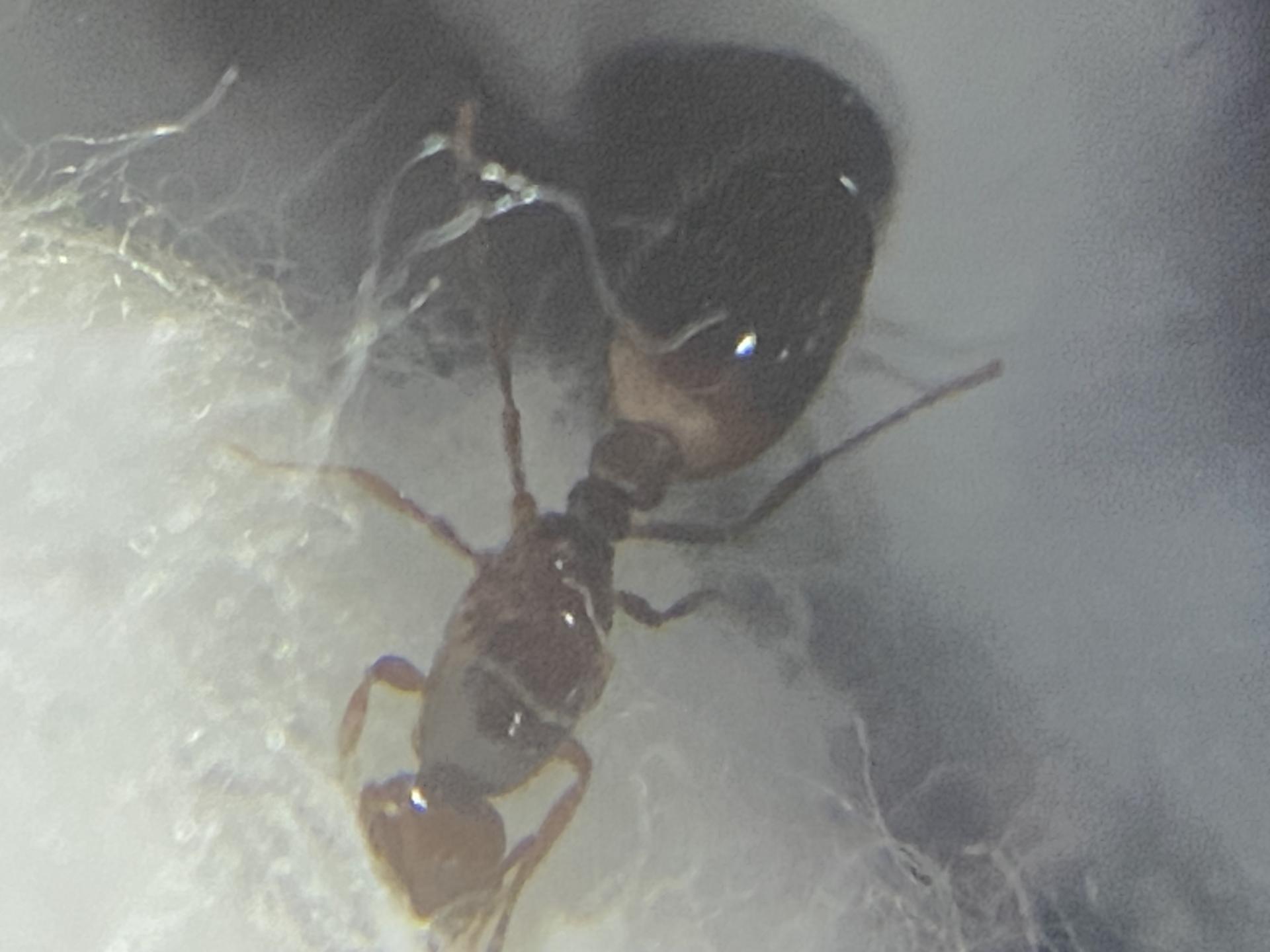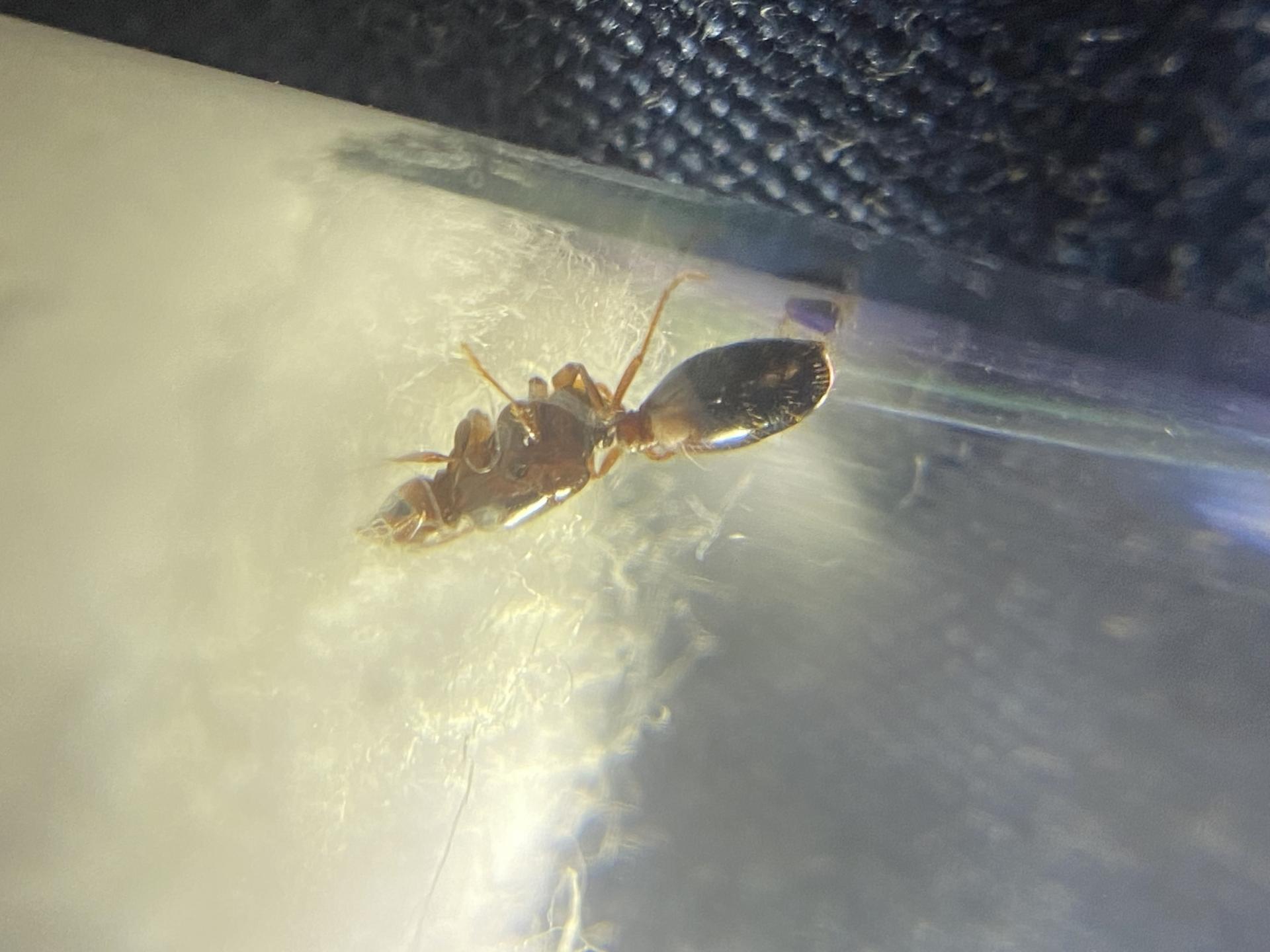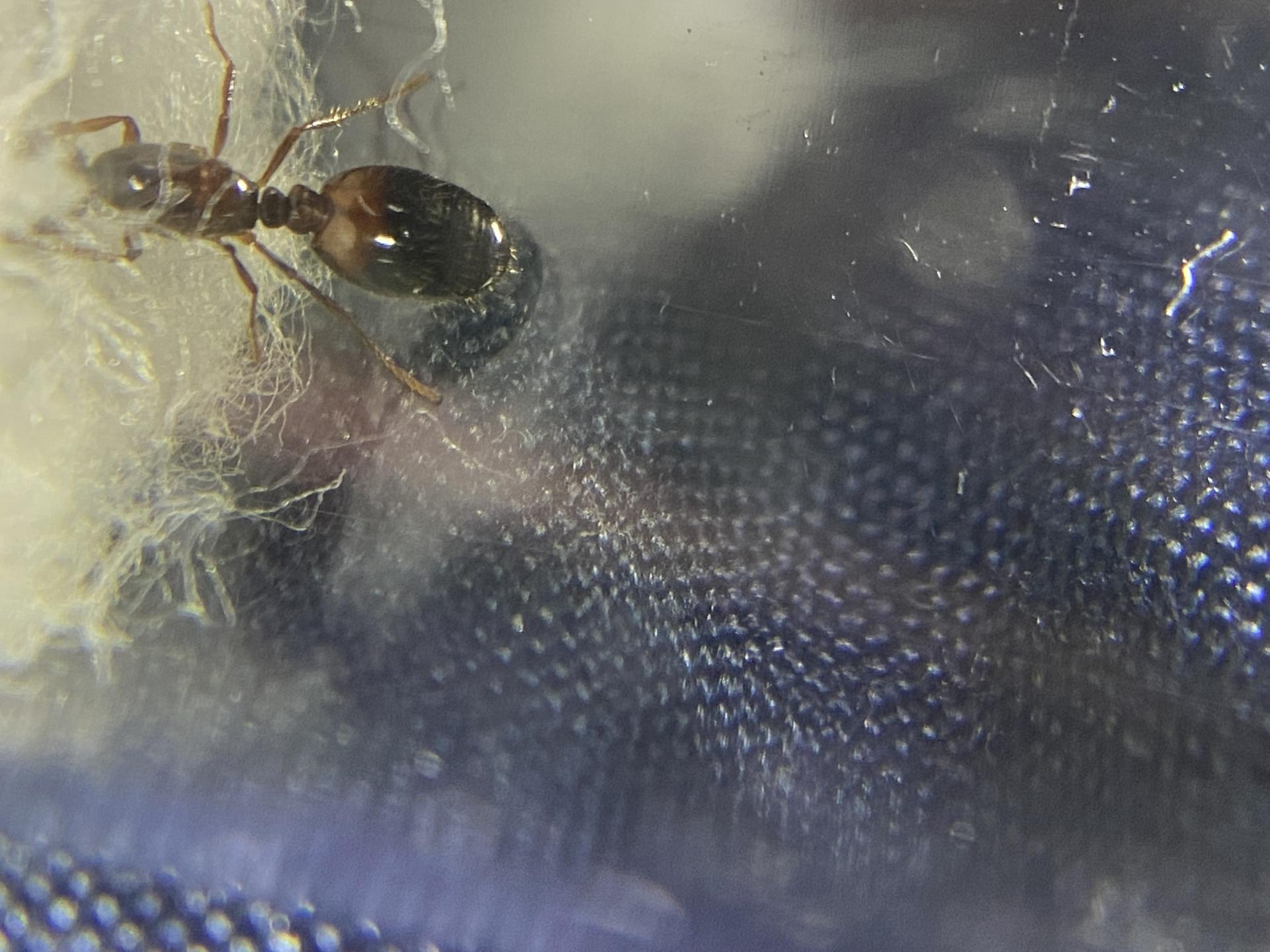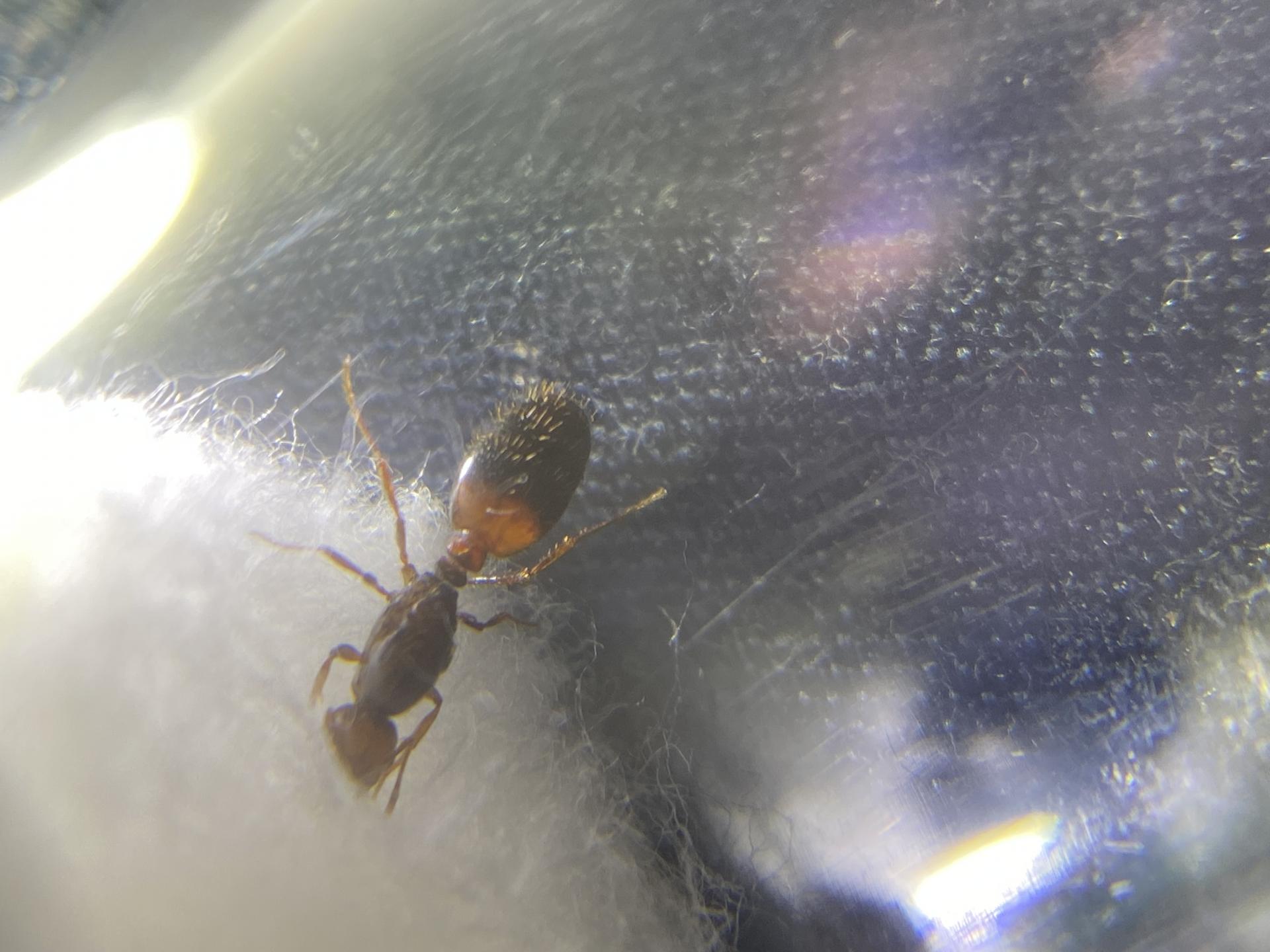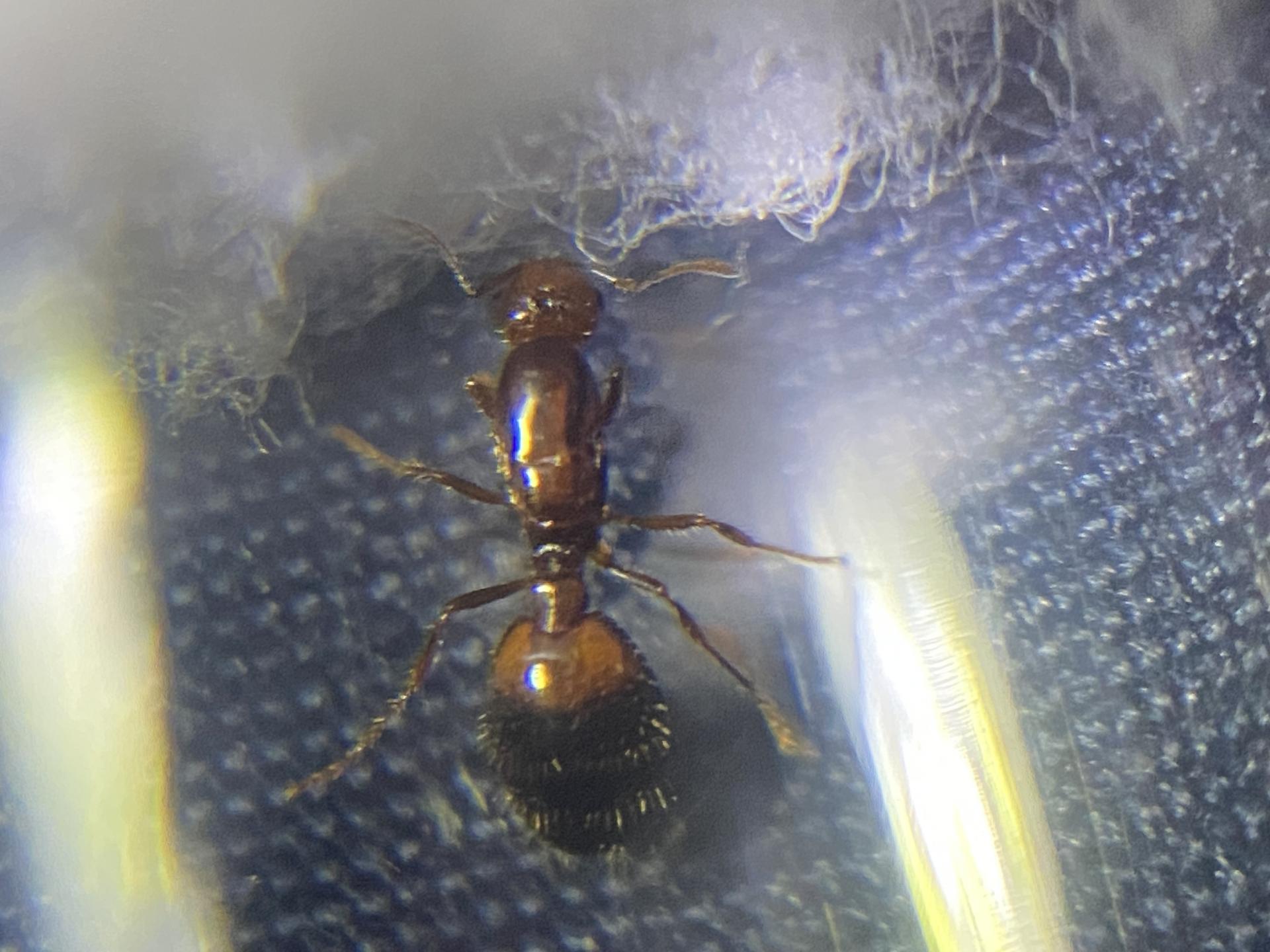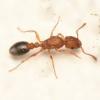- Formiculture.com
- Forums
- Gallery
- Members
- Member Map
- Chat
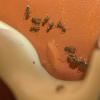
Solenopsis Xyloni/Invicta/Geminata?
Started By
AsdinAnts
, Jan 30 2024 9:37 PM

Best Answer ReignofRage , January 31 2024 - 12:59 PM
Without a better image, there is basically no way to tell. All of the factors mentioned above are negated by the amount of variation in both S. invicta and S. xyloni. S. geminata can be negated by locale (Newhall, Santa Clarita, CA) alone; all factors mentioned above barely hold up for select populations of S. geminata. There are plenty of areas with S. geminata that have slender-head gynes and gynes that are deeply infuscated if not nearly all black. The occurence of slender-head gynes and deeply infuscated gynes is simply due to S. geminata being a messy complex of species rather than one "true" species. In lateral view, the petiole on gynes of the three species are nearly identical - the positioning of the petiole changes with the position the queen is holding her gaster at. Additionally, S. geminata does not solely fly in summer as there are plenty of flight records across nearly every month of the year, if not every single month of the year. With the provided images, it's nearly impossible to see any thoracic detail to use a "checkered pattern" as a negating factor. Although it's uncommon, S. xyloni can and on occasion do fly through winter.
It's not impossible for it to be S. invicta and it likely is S. invicta, however it simply can't be taken past genus with these photos.
Go to the full post
12 replies to this topic
#1
 Offline
-
Posted January 30 2024 - 9:37 PM
Offline
-
Posted January 30 2024 - 9:37 PM
I caught a Solenopsis sp queen at my karate dojo in California, Newhall. She was just walking around the floor at around 8 p.m. I need help IDing her.
Currently keeping
-A. occidentalis
-B. patagonicus
-F. neogagates
-M. invidia
-Stennama spec..
I will want to also keep some lasius in the future.
-A. occidentalis
-B. patagonicus
-F. neogagates
-M. invidia
-Stennama spec..
I will want to also keep some lasius in the future.
#2
 Offline
-
Posted January 31 2024 - 4:46 AM
Offline
-
Posted January 31 2024 - 4:46 AM
Pic? Or description?
Keeping:
3x - S. molesta
1x - C. chromaiodes
2x - F. pallidefulva
2x - C. cerasi
1x - B. depilis
2x P. imparis (colonies) 3x P. imparis queens (1x queen in test tube, 3x queens in test tube, and 6x queens in another test tube. Can't wait to see the results!)
Check out my C. chromaiodes journal here: https://www.formicul...aiodes-journal/
#3
 Offline
-
Posted January 31 2024 - 7:39 AM
Offline
-
Posted January 31 2024 - 7:39 AM
yea, sorry, my wifi was acting up last night so I couldn’t post a photo. I took photos of her last night, but she had her head inside the cotton.
Currently keeping
-A. occidentalis
-B. patagonicus
-F. neogagates
-M. invidia
-Stennama spec..
I will want to also keep some lasius in the future.
-A. occidentalis
-B. patagonicus
-F. neogagates
-M. invidia
-Stennama spec..
I will want to also keep some lasius in the future.
#4
 Offline
-
Posted January 31 2024 - 11:28 AM
Offline
-
Posted January 31 2024 - 11:28 AM
Upon further inspection, S. xyloni and S. invicta seem to match, your queen. S. geminata can immediately be crossed out because of the larger head size and variants (tend to be much brighter in color). Nuptial flights for S. geminata are also in summer. And first petiole goes in more of an up position for S. geminata. S. xyloni looks very similar to pic, but the only thing that does not match is the red checkered pattern on the abdomen, which is found on most variants. But I could be mistaken and this could just be a different variant from the main one. And nuptial flights range from May to September. Petioles for both species look exactly the same, and hair on legs are also about the same. So that brings it down to S. invicta, which has much more similarities. One thing is that the species flys from spring to summer, which deeply relates to when you found the queen. S. invicta queens also naturally lacks the checkered pattern on the abdomen. But on the other hand it could just be an overall late flying S. xyloni with just a different variant, which moth could be possible. The best way to ID is to wait for workers. For S. invicta workers, they will be a much darker red, and for S. xyloni workers, they will be a much brighter red, with a black gaster. In conclusion though, I believe that this queen is an S. invicta queen because of the non-checkered abdomen, and overall darker appearance.
Edited by Artisan_Ants, January 31 2024 - 1:07 PM.
Keeping:
3x - S. molesta
1x - C. chromaiodes
2x - F. pallidefulva
2x - C. cerasi
1x - B. depilis
2x P. imparis (colonies) 3x P. imparis queens (1x queen in test tube, 3x queens in test tube, and 6x queens in another test tube. Can't wait to see the results!)
Check out my C. chromaiodes journal here: https://www.formicul...aiodes-journal/
#5
 Offline
-
Posted January 31 2024 - 12:59 PM
Best Answer
Offline
-
Posted January 31 2024 - 12:59 PM
Best Answer
Without a better image, there is basically no way to tell. All of the factors mentioned above are negated by the amount of variation in both S. invicta and S. xyloni. S. geminata can be negated by locale (Newhall, Santa Clarita, CA) alone; all factors mentioned above barely hold up for select populations of S. geminata. There are plenty of areas with S. geminata that have slender-head gynes and gynes that are deeply infuscated if not nearly all black. The occurence of slender-head gynes and deeply infuscated gynes is simply due to S. geminata being a messy complex of species rather than one "true" species. In lateral view, the petiole on gynes of the three species are nearly identical - the positioning of the petiole changes with the position the queen is holding her gaster at. Additionally, S. geminata does not solely fly in summer as there are plenty of flight records across nearly every month of the year, if not every single month of the year. With the provided images, it's nearly impossible to see any thoracic detail to use a "checkered pattern" as a negating factor. Although it's uncommon, S. xyloni can and on occasion do fly through winter.
It's not impossible for it to be S. invicta and it likely is S. invicta, however it simply can't be taken past genus with these photos.
- gcsnelling, AsdinAnts and Artisan_Ants like this
#6
 Offline
-
Posted January 31 2024 - 2:54 PM
Offline
-
Posted January 31 2024 - 2:54 PM
#7
 Offline
-
Posted January 31 2024 - 4:28 PM
Offline
-
Posted January 31 2024 - 4:28 PM
With light, I’m very sure that this is S. invicta. Again, the variant is just different, and that is fairly common with the genus of solonopsis. The petioles are in a much straighter position making it easier to tell the difference. The last petiole (the one connecting to the gaster) is larger and bigger in appearance form the previous images (the petioles look much bigger than S. xyloni; but this can vary really, and I’m not fully sure because I believe that both are about the same size). Thorax for S. invicta from others pictures I have see are relatively similar, (thorax obviously not accurate for ID, but flying dates for sure, and last petiole kind of; are). But I have to admit, from what I have seen, that this variant is fairly intriguing, and makes quite a challenge to get the solid ID. Please correct me If I am wrong though.
Edited by Artisan_Ants, January 31 2024 - 4:42 PM.
Keeping:
3x - S. molesta
1x - C. chromaiodes
2x - F. pallidefulva
2x - C. cerasi
1x - B. depilis
2x P. imparis (colonies) 3x P. imparis queens (1x queen in test tube, 3x queens in test tube, and 6x queens in another test tube. Can't wait to see the results!)
Check out my C. chromaiodes journal here: https://www.formicul...aiodes-journal/
#8
 Offline
-
Posted January 31 2024 - 5:09 PM
Offline
-
Posted January 31 2024 - 5:09 PM
It is S. invicta, however the whole petiole and postpetiole thing doesn't make sense at all. It is the more typical form of monogynous S. invicta for California which is a little more bulky and colorful than the polygynous populations.
- gcsnelling, OiledOlives and Artisan_Ants like this
#9
 Offline
-
Posted February 1 2024 - 4:36 AM
Offline
-
Posted February 1 2024 - 4:36 AM
Yeah sorry about that. Just looking, and trying to find the differences that's all.
Edited by Artisan_Ants, February 1 2024 - 4:46 AM.
Keeping:
3x - S. molesta
1x - C. chromaiodes
2x - F. pallidefulva
2x - C. cerasi
1x - B. depilis
2x P. imparis (colonies) 3x P. imparis queens (1x queen in test tube, 3x queens in test tube, and 6x queens in another test tube. Can't wait to see the results!)
Check out my C. chromaiodes journal here: https://www.formicul...aiodes-journal/
#10
 Offline
-
Posted February 1 2024 - 7:32 AM
Offline
-
Posted February 1 2024 - 7:32 AM
Thank you for your help with this everyone!
- Artisan_Ants likes this
Currently keeping
-A. occidentalis
-B. patagonicus
-F. neogagates
-M. invidia
-Stennama spec..
I will want to also keep some lasius in the future.
-A. occidentalis
-B. patagonicus
-F. neogagates
-M. invidia
-Stennama spec..
I will want to also keep some lasius in the future.
#11
 Offline
-
Posted February 1 2024 - 10:00 AM
Offline
-
Posted February 1 2024 - 10:00 AM
Yeah no problem
Edited by Artisan_Ants, February 1 2024 - 4:42 PM.
Keeping:
3x - S. molesta
1x - C. chromaiodes
2x - F. pallidefulva
2x - C. cerasi
1x - B. depilis
2x P. imparis (colonies) 3x P. imparis queens (1x queen in test tube, 3x queens in test tube, and 6x queens in another test tube. Can't wait to see the results!)
Check out my C. chromaiodes journal here: https://www.formicul...aiodes-journal/
#12
 Offline
-
Posted February 3 2024 - 8:40 PM
Offline
-
Posted February 3 2024 - 8:40 PM
here are two new photos of the queen, not sure if they will help identifying the queen.
We need a good photo of the clypeal teeth. Although, looking at the coloration, it might be a S. invicta queen. But a clypeal teeth photo is needed. All I know is that is isn't S. geminata.
Currently keeping: Pheidole obscurithorax (FINALLY I CAN STUDY THEM AND HAVE THEIR COOL MAJORS ![]() ), Tetramorium bicarinatum, Solenopsis spp. (probably xyloni, the queens are tiny hehe)
), Tetramorium bicarinatum, Solenopsis spp. (probably xyloni, the queens are tiny hehe)
Wanting: Atta texana, Camponotus planatus (PLEASE PLEASE PLEASE CAN SOMEONE HOOK ME UP WITH ATTA)
Previously kept: Monomorium minimum, Pheidole dentata
"ATTAAAAAAAAAAAA!!!!!!!!!!!" -Me
"AAAAAAAATTTTTTTTTAAAAAAAAAAAAAAAAAAAAAAAAAA!!!!!!!!!!!!!!!!!!!!!!!!!!!!!!!!!!!!!!!!!!!!!!!!" -Even more me
"AAAAAAAAAAAAAAAAAAAAAAAAAATTTTTTTTTTTTTTTTTTTTTTTTTTTTTTTTTAAAAAAAAAAAAAAAAAAAAAAAAAAAAAAAAAAAAAAAAAAAAAAAAA!!!!!!!!!!!!!!!!!!!!!!!!!!!!!!!!!!!!!!!!!!!!!!!!!!!!!!!!!"- Me personified
#13
 Offline
-
Posted February 4 2024 - 2:15 PM
Offline
-
Posted February 4 2024 - 2:15 PM
The coloration of this queen matches documented coloration patterns of other S. invicta alates/de-alates. And head size is also the same for recorded S. invicta queens, (which obviously isn’t the best if not the worst distinction). But overall; you have a point.We need a good photo of the clypeal teeth. Although, looking at the coloration, it might be a S. invicta queen. But a clypeal teeth photo is needed. All I know is that is isn't S. geminata.here are two new photos of the queen, not sure if they will help identifying the queen.
Keeping:
3x - S. molesta
1x - C. chromaiodes
2x - F. pallidefulva
2x - C. cerasi
1x - B. depilis
2x P. imparis (colonies) 3x P. imparis queens (1x queen in test tube, 3x queens in test tube, and 6x queens in another test tube. Can't wait to see the results!)
Check out my C. chromaiodes journal here: https://www.formicul...aiodes-journal/
0 user(s) are reading this topic
0 members, 0 guests, 0 anonymous users




